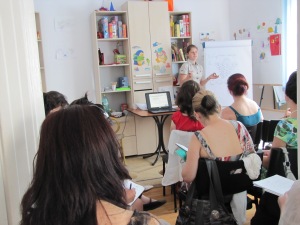ASOCIATIA PENTRU INTERVENTIE TERAPEUTICA IN AUTISM
organizeaza cursul cu tema:
METODE SPECIFICE IN CORECTAREA SI STIMULAREA LIMBAJULUI LA PRESCOLARI
Trainer: Logoped Ana Burla-Turcanu – specializare in dezvoltarea, stimularea si corectarea limbajului verbal si non-verbal, si terapia si recuperarea copiilor cu autism Data: Modul I 15-16 septembrie si Modulul II 20 – 21 octombrie 2012 la sediul AITA in str. Drumea Radulescu, nr. 9, sector 4, Bucuresti (zona Tineretului) Durata: 30 de ore de curs distribuite astfel: 12 ore fiecare modul (sambata si duminica intre orele 10.00 – 16.00) + 6 ore practica asistata. Orele de practica se vor desfasura intre cele 2 module, la Centrul AITA in doua sedinte a cate 3 ore. Aceste ore se vor efectua in cursul saptamanii, de luni pana vineri intre orele 09.00 – 18.00
Cursul va fi structurat in 2 module si va avea urmatoarea tematica: Clasificarea tulburarilor de limbaj – prezentare succinta
-Tulburari de scris-citit
-Tulburari de ritm si fluenta
-Tulburari de pronuntie
-Tulburari de voce
-Tulburari polimorfe
-Tulburari de dezvoltare
Fisa logopedica
-Consemnarea rezultatelor examinarii
-Interpretarea datelor
Terapia cu caracter general
-Educarea miscarilor articulatorii
-Educarea respiratiei
-Educarea auzului fonematic
Terapia cu caracter specific
- Etapele programului specific de terapie logopedica
Prezentarea si crearea unui program specific de terapie logopedica
Interventia logopedica la copiii cu tulburari pervazive de dezvoltare
-Autismul. Semne si caracteristici.
-Comunicarea si limbajul copilului autist
-Etapele formarii limbajului
-Metode alternative de comunicare
Modalitati de interventie psihoterapeutica
-Programe de lucru
-Jocuri
-Exercitii
Rolul familiei şi implicarea ei in procesul terapeutic Prezentare cazuistica (audio şi/sau video)
Taxa de curs: 250 lei fiecare modul, se va achita in contul nostru.
Pentru a efectua plata este necesar sa aveti la dumneavoastra anuntul de curs. Informatii si inscrieri: asociatia.aita@yahoo.com, 0753 055852 de luni pana vineri intre orele 09.00 -18.00
Trimiteti mail cu urmatoarele date: nume, prenume, profesie, date de contact, precum si dovada achitarii taxei (chitanta scanata) in contul nostru: ASOCIATIA PENTRU INTERVENTIE TERAPEUTICA IN AUTISM Cont: RO51BUCUE47774732511RO01 deschis la ALPHA BANK sucursala Perla, specificand „curs + numele dvs” Se acorda suport de curs. Se acorda diploma de participare. Nu se acorda credite din partea COPSI.
